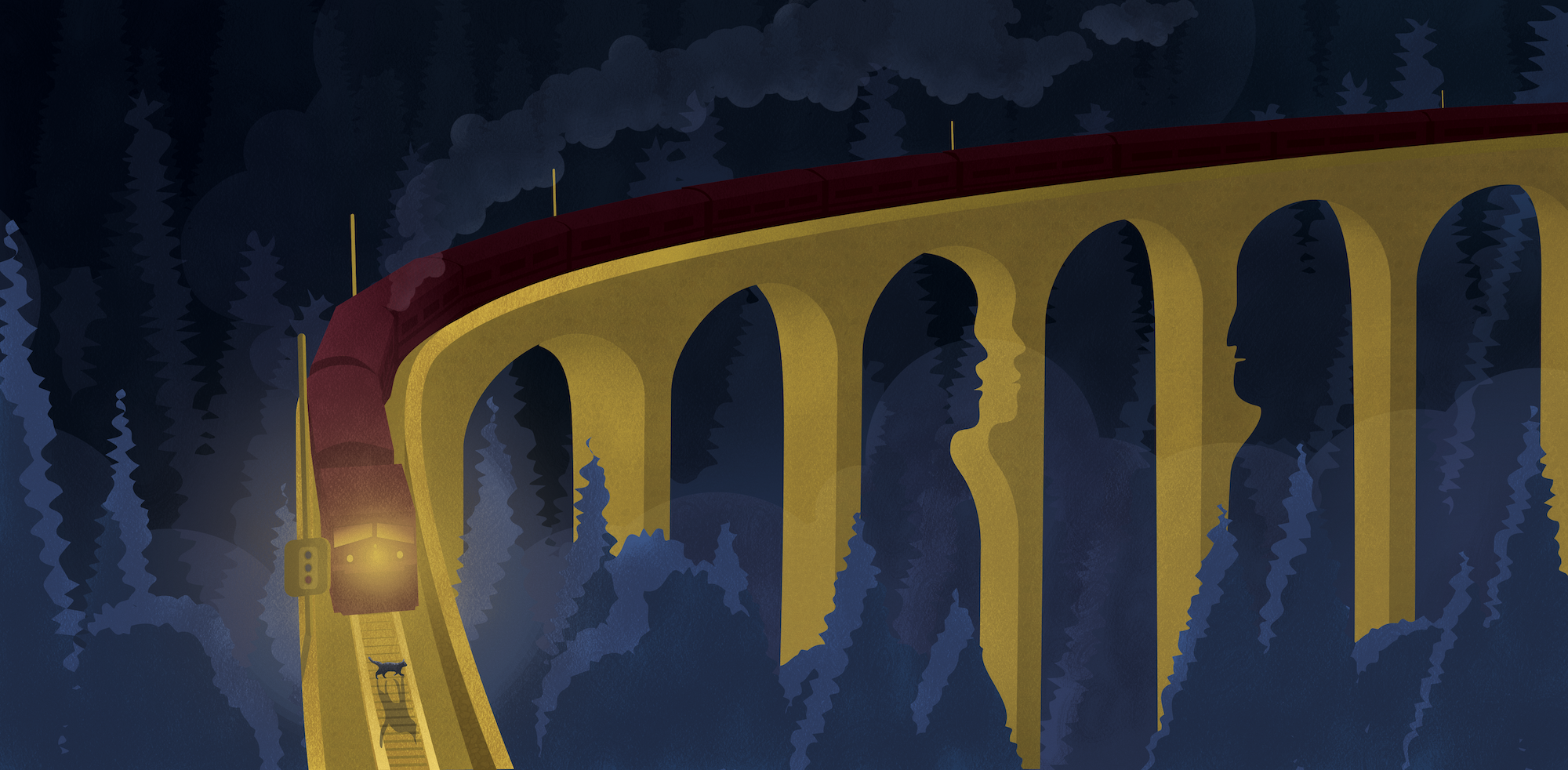Whistle Posts of Forgotten Railroads
by Jason Sanford
Illustrated by Marcia Diaz | Edited by Maurice Broaddus
Copyedited by Chelle Parker
February 2021
2795 words — Reading time: around 13 minutes
The train tracks run not by my house but near, along a railroad viaduct slicing our city into a here and a there, into this neighborhood and that. A raised battlement of weeds and trees topping century-old cement and cut stone walls lifting trains above our lowly city streets.
In the summer, the trees hide all but glimpses of passing trains. In the winter, the shipping containers and endless tank cars flicker among bare branches. At night I watch from my bedroom window as the engines’ headlamps burn the tracks into razor cuts of brightness.
And always the whistles. Forever days of whistles.
When cancer claimed my husband’s final months, the train whistles called to him. Where before Desmond would sleep through the whistles, instead he began to wake. He’d roll out of bed and stagger toward the door despite his body screaming to pain, desperate to answer the whistles’ call.
I would shut the windows and soundproof the walls with blankets. But still the whistles would call to him.
“Let’s join the trains, Andi,” he whispered one night as a whistle called out. “I want to live those times again. With you.”
I was so exhausted from taking care of him that I kissed him dryly on the forehead before walking into the living room to cry.
When Desmond passed, I buried him in a graveyard far from the train tracks. The day after his burial, I removed the blankets from the bedroom walls and windows and again listened.
Sometimes I wake before life happens. Emerge from sleep to discover, a moment later, the neighbors fighting on the sidewalk or a loud crash as a drunk driver sideswipes my parked car. Did I know this was coming? Is it mere coincidence, me waking those times but failing to wake the hundreds of other moments where I slept through far greater events?
Either way, I wake this night. I roll over in bed to see 2 a.m. on the alarm clock. The breeze slips cool through the open window’s screen.
The cat growls slightly from beside me on the bed, annoyed I’m waking him instead of the other way around. I scratch his ears as apology.
I look out the window at the dark street — rusted and dented cars parked along the curb, the dead streetlight the city never fixes. Beyond that, my neighbors’ homes. And several blocks over, the railroad rising above everything.
A blazing light from an approaching train illuminates the top of the viaduct. I remember my Maw Maw’s house on the other side of the tracks. How, as a child, I discovered a hole in her wooden backyard fence where I could see the trains. Every time a whistle blew, I ran to that hole and watched the passing trains and dreamed of where they were going.
Once I grew up, I realized trains only travelled to more places like where I lived. But now, as I lie in my bed a lifetime later and watch the lights of this approaching train, I taste the excitement I’d known as a child.
The whistle slices the night air, pulling me toward its shrill cry. The whistle calls for twenty seconds, maybe thirty, far longer than usual. When the whistle stops, I hear another sound — the grinding screech of the train’s brakes.
But why?
I stare out the window as silence returns. Stick figures with flashlights walk up and down the tracks alongside the stopped train, as if searching for something.
Unsure what’s going on, I eventually fall back asleep.
In the morning, I learn a man laid down on the tracks and was run over. A suicide, for reasons unknown. The body no longer in a fit condition. And not the first suicide.
My annoying next-door neighbor loudly proclaims that those damn tracks call people to them. That there’s something wrong with the trains here. Which is why she wears earplugs when she sleeps.
I shake my head. Earplugs didn’t help Desmond. Nothing stops you from hearing that whistle.
I can’t sleep. Every night the whistles scour my mind. They pull me awake and turn my every moment into dreams of chasing after them.
Nothing has changed, I tell myself. These are the same trains which have always passed through the city. The same whistles I’ve heard and ignored and loved and pretended were anything but what they are since I was a kid.
Nothing has changed.
Nothing except Desmond, who is gone.
I didn’t believe him when he said the whistles called to him.
I believe him now.
The cat curls up beside me as I toss and turn, unable to sleep. For once, the cat is patient, not protesting when I bump against him. He’s a giant Maine Coon, nearly half as long as I am tall when he stretches out. He cuddles closer, as if comforting me.
He did the same with Desmond in his final weeks. He’d always been closer to Desmond than me, even though my husband refused to give the cat a name.
“Why force a name on a cat?” Desmond always said. “He knows his name. Doesn’t need us giving him one.”
I jokingly called the cat Nameless, and still do.
I’m exhausted after weeks of sleeping in fits and starts as the whistle slips its way into my mind. When morning comes, I scream at the trains. I curse them with every hate I know before collapsing back into bed for a few pitiful hours of sleep.
Nameless is extremely patient through all this, asking only for ear scratches when I’m awake.
One morning, after yet again failing to sleep, I wrap a sweater around my waist and prepare to leave. I pick up my walking stick, because my hip sometimes spasms on long hikes. I lock my door, which is silly because there’s nothing in my house worth stealing. Better to let someone rummage through my life than to spend money repairing a busted-down door.
But I still lock it. Old habits and all.
When I turn around, Nameless sits on the porch, waiting for me. He’s never allowed outside. While Desmond always loved cats, he also said they were murder machines, destroying birds and chipmunks without a care. So we kept Nameless inside.
I try to grab the cat but he jumps out of reach.
Irritated, I ignore him. With my stick tapping on the hot asphalt, I walk down the street as Nameless follows.
Desmond refused further treatment when the end was near. Refused moving into hospice because he wanted to spend his final days with me. I was touched by this — at first, before I realized what he’d dumped on me. But initially I was moved by this statement of his love.
A nurse helped a few hours each day, but that wasn’t enough for someone dying. So I learned all I could. Such as Cheyne-Stokes respirations, those irregular breaths found in dying people. Very deep and rapid breathing followed by short breaths.
I also learned the blues, pales, and other colors of a dying person’s skin. Learned that Desmond’s skin, the skin I’d loved for half a century, was transforming into something totally unlike what it’d been before.
But the worst was the delirium. Sometimes Desmond saw me, sometimes not. Sometimes Nameless was his cat, sometimes not.
And sometimes the train whistles called out to his mind and soul.
Except that wasn’t delirium. Because the whistles now call to me.
What else was I wrong about?
Nameless and I walk up a winding dirt path to the top of the viaduct. Kids use this path to reach the top and place quarters on the tracks, where they’re crushed into razor thinness and can slice the bullies at school who prey on the helpless.
I saw all that and worse in my career driving a school bus.
I don’t know why that thought pops into my head. I shake it off and continue climbing the path until I reach the top.
Crossties and ballast. Sharp-edged rocks to interlock. Discarded trash dumped on the stones. An ancient TV, broken, now holding a scummy pond with floating circuit boards. A shattered fake-crystal chandelier to refract the headlights of approaching trains.
Walking along the crossties and tracks is the easiest, with the ballast packed level and using the wood as steps. But I fear falling and hitting my head and the train running over me, so I walk the edge of the grade on uneven stones which shift underfoot. Only my walking stick keeps me standing.
Nameless walks along the top of a single steel rail. I warn him to be careful. He ignores me and walks on, tail pointing defiantly at the sky.
The first time a train approaches, Nameless lays a single ear against the rail. I’m not sure what he’s listening to because we can both hear the whistle, but Nameless seems satisfied. He hops from the rail and joins me on the edge of the grade. I step into the trees and bushes so the engineer won’t see me and call the railroad police. The cat doesn’t care if he’s seen and glares with contempt at the onrushing train.
It’s a freight train pulling black tanker cars of oil, white letters on the sides specifying capacities and pressures. I try to count the cars but the train is long — miles long, maybe even longer? It’s like counting sheep. I stagger back and nearly fall, but the trees and sticker bushes stop me. They ease me to the ground, where I fall asleep.
I wake achy and sore, bruised by the stones. I’m also bleeding from four puncture marks on my right calf, which look suspiciously like a cat bite.
Nameless shrugs, if cats could shrug, and stares as if to say I can’t prove it was his teeth which bit me.
I feel myself falling back to sleep so Nameless nips me again, although not as hard as before. I sit up, adrenaline slamming me as I realize I’m sitting only a few feet from the train tracks. I don’t remember moving. How’d I get so close to the tracks while asleep?
Was this one of those times I woke before something happened? Except this time the something happening would have been me getting run over by a train.
I stand despite my grogginess. Nameless meows, something he never does. I wonder if he’s encouraging me to get moving.
I pick up my walking stick and again follow the tracks.
I should have exited the viaduct hours ago. Even for a slow walker like myself, the viaduct doesn’t take this long to hike. The tracks should have already dropped back to ground level. I should have returned to the world of people.
Instead, I still follow the tracks. Nameless still pads alongside me.
I pass old wooden whistle post signs painted with a large W, telling the train engineer to blow the whistle. Which they do.
Trains speed past every thirty minutes. The whistles call to me. Like they did for Desmond. Each whistle louder and stronger and more enticing.
As one train rattles by, I remember wiping the urine and crap off Desmond’s stick-figure frame when he could no longer get out of bed. As another train jams past, I remember the exhaustion I felt from day after day of caring for him.
I stagger toward the trees and bushes along the side of the viaduct as another train speeds by. I remember Desmond’s final weeks. I was so exhausted I couldn’t feel anything of the love I’d once known for the man. Fifty years together, and I didn’t care if he lived or died. I merely worked mindlessly, taking care of him. Rote living, over and over.
The memories slap me into guilt at how I’d dared to hold Desmond’s hand without emotion as he passed. I’m furious at myself for lying, for telling him I loved him even though I was mentally and physically spent.
I had loved him. I’d always loved him. But those final weeks pushed all emotions from my heart.
I scream as another train runs by. The whistle grabs me, pulls out the pain I’d bottled up for so long as it begs me to join in the train’s final cry of release.
I walk toward the tracks. To throw myself under the train even as I feel myself slipping back into sleep.
But Nameless shrieks and I come back to myself. I grab the sweater from my backpack and wrap it around my waist, tie the sleeves around the trunk of a small tree. I double knot the sweater arms, triple knot them, leaving me hugging the tree as I pass out.
I wake still tied by my sweater to the tree. But the bark is shredded and my fingers bloody, as if I’d clawed in my sleep at the tree.
Nameless rubs against me, something he rarely does. Desmond said such displays were not a sign of affection but how cats marked their territory. If so, Nameless seems very happy I’m alive enough to mark as his own.
My fingers are so cut and hurt that it takes half an hour to unknot the sweater and free myself from the tree. During that time, a train rattles past.
As the train passes, I remember my wedding day, a memory so fresh that when I close my eyes, I again see Desmond standing before me. I’d been so nervous as I entered that church and stood before friends and family and the preacher about to pronounce us man and wife.
At the time, I’d feared I’d made a mistake. That I was marrying too young. That Desmond and I wouldn’t last. That he didn’t love me like I loved him.
But standing before the preacher, as I looked into Desmond’s eyes, I found myself shivering in delight. I grabbed Desmond’s hand and pulled him toward me, the preacher and audience laughing because we hadn’t yet said our vows.
I didn’t care. Desmond was mine and I was his.
I shake myself from the memory. Nameless stands between me and the train, as if blocking me from throwing myself under those steel wheels. As the train rolls away, my wedding also recedes back into a memory fifty years in the past.
Nameless growls softly and, as if he’s speaking as clearly as Desmond once did, I finally understand. The train is pulling the memories from me. Calling out to the whistle posts of my life.
I’d thought those whistles were calling Desmond to travel with the train, but what if they were actually pulling him into memories? Inviting him to abandon his painfully slow death by returning to, and living within, a special moment of his life?
Had he been tempted by our wedding day? The birth of our child? The day we met? Or had there been a day unrelated to me which fluttered through his mind as the whistles called out?
I cry as I watch the train roll down the tracks away from me. Desmond could have fled his pain. Been content and happy in memories. Instead, he spent a few more days with me, not knowing I was so exhausted and worn out that I felt nothing for him as he died.
I hit my walking stick over and over against the train tracks. Nameless sits beside me and leaves me alone until I’m cried out.
From far away, I hear the faint whistle of another train approaching.
“This is it, huh, Nameless?” I mutter. “End my pain by letting the train wrap me in memories even as I dance under its wheels.”
Nameless stares, not reacting. The cat knows this is my choice to make, not his.
I walk towards the edge of the viaduct as the train whistle grows louder. For a moment, the trees and shrubs block my exit, but I refuse to be stopped. I push through and find a dirt path leading down the slope.
I look back at Nameless, who still sits by the tracks. I remember Nameless and Desmond spending hours sleeping next to one another. Talking to one another without saying a word. Being best friends for years.
Nameless was always more Desmond’s cat than mine.
Does the whistle now tempt Nameless with his own memories?
“Hey!” I yell. “Don’t you do that to me.”
The train whistle blows louder as Nameless looks at me. The cat flicks his tail — in happiness? irritation? — as he runs from the tracks and down the path before me.
I follow.
It takes a few hours to walk home, but neither Nameless or I voice any complaints.


